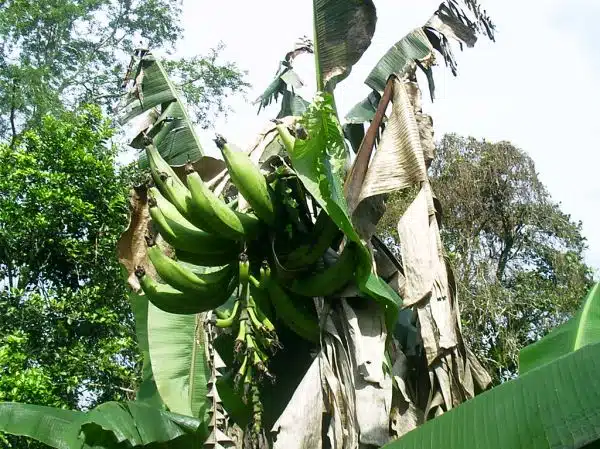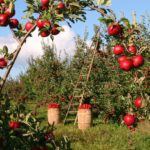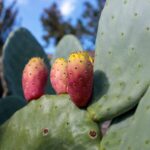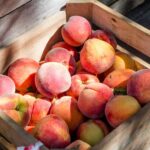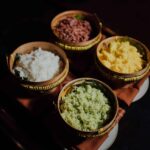Plantain trees are a perennial staple crop that belongs to the banana family. They grow in tropical climates and are widely cultivated for their fruit and leaves, which are used in various culinary dishes. Plantain trees require little care and attention once established, making them an ideal crop for those who want to cultivate their own food.
As a plantain tree specialist, I have studied these plants extensively and have developed a comprehensive guide on how to care for and grow them successfully. Whether you are a seasoned gardener or a beginner, this guide will provide you with all the information you need to cultivate healthy plantain trees that will yield bountiful harvests. From selecting the right soil type to pruning techniques, this guide covers every aspect of plantain tree care, ensuring that your plants thrive and produce delicious fruits year after year.
Understanding Plantain Tree Basics
Plantain tree propagation techniques are essential to understand if one aims to grow this tropical fruit plant. Typically, the most common methods of propagation include sucker separation and tissue culture. Sucker separation refers to removing a sucker plant from its parent plant and replanting it in the soil. Conversely, tissue culture involves taking a small piece of the parent plant’s tissue and growing it in a laboratory setting. These techniques prove successful for producing healthy plants that can withstand various environmental conditions.
Plantain tree varieties offer different advantages depending on the climate of their growth location. For instance, the Horn variety suits hot, dry climates, while French Maricongo performs well in cold climates. The Orishele cultivar thrives in areas with high humidity levels and rainfall. Knowing which variety thrives best in particular environments is vital for ensuring high yields and healthy plant growth.
Understanding these basics allows gardeners to produce sustainable harvests of this popular fruit crop. Moreover, with proper care and attention, plantain trees can thrive in almost any environment around the world. In the following section, we will explore how to select suitable soil for planting these trees without compromising their growth potential.
Selecting The Right Soil For Plantain Trees
Soil composition is a crucial factor that affects the growth and development of plantain trees. The ideal soil for plantains is loamy soil, which consists of sand, silt, and clay in equal proportions. This type of soil provides the necessary nutrients and moisture retention capacity needed for optimal plantain growth. A pH range of 5.5 to 7.0 is also suitable for plantain trees.
Soil preparation is essential before planting any crop, including plantains. To prepare the soil for planting, clear the area of weeds and debris, then loosen the topsoil with a hoe or rake. You can also incorporate organic matter such as compost or manure to improve soil fertility and structure. It is important to note that over-fertilization can lead to poor growth due to salt accumulation in the soil.
In summary, selecting the right soil for your plantain trees is critical for their growth and productivity. Loamy soil with a pH range of 5.5 to 7.0 provides an ideal environment for plantains to thrive. Proper soil preparation through clearing weed debris and incorporating organic matter will further enhance your plantain tree’s success rate by improving the overall quality of your planting area.
To ensure continued healthy growth of your plantain trees, proper watering and fertilization are crucial factors that require attention.
Plantain Tree Watering And Fertilization
As we all know, the plantain tree is a tropical plant that requires specific care to grow and thrive. One of the most crucial aspects of caring for a plantain tree is watering techniques. Proper watering ensures that the plant receives enough moisture without drowning it, which can cause root rot and other issues.
To water your plantain tree correctly, it’s essential to understand its unique needs. First, you should always water your tree deeply and thoroughly rather than giving it frequent shallow watering. This helps the roots grow deep into the soil and absorb more nutrients. Second, you should avoid getting water on the leaves as much as possible, as this can lead to fungal growth and other problems.
In addition to proper watering techniques, fertilization is also crucial for the health of your plantain tree. A regular fertilization schedule will provide your trees with essential nutrients that they need to grow correctly. You should use a slow-release fertilizer that provides nitrogen, potassium, and phosphorus in equal amounts. Fertilize your tree every six months or so for best results. With proper watering techniques and a regular fertilization schedule, you’ll be able to enjoy healthy, thriving plantain trees in no time!
As critical as proper watering techniques are for growing healthy plantain trees, there are other factors that must be considered when caring for these tropical plants. One such factor is sunlight requirements. Adequate exposure to sunlight is essential for optimal growth and fruit production. Understanding how much sunlight your plantain tree needs can help ensure its success in your garden or orchard area.
Plantain Tree Sunlight Requirements
Having discussed the importance of watering and fertilizing your plantain tree, it is now time to delve into its sunlight requirements. As a tropical plant, the plantain tree thrives in areas with high levels of sunlight exposure. However, too much direct sunlight can be detrimental to its growth and development. Therefore, it is important to understand the ideal amount of sunlight exposure that your plantain tree requires.
Plantain trees require an average of 12 hours of sunlight per day to thrive. This means that they need to be planted in areas with plenty of access to direct sunlight. Additionally, they should be protected from excessive wind or harsh weather conditions as this can damage their leaves and stunt their growth. In contrast, if your plantain tree does not receive adequate amounts of sunshine, it may become weak and susceptible to pests and diseases.
While the plantain tree requires ample amounts of sunlight exposure for optimal growth, it also needs some shade at certain times during the day. This is particularly important during intense heat periods or hot summer months when too much direct sunlight can scorch its leaves. Therefore, planting your plantain trees under larger trees or providing artificial shading can help protect them from harsh weather conditions while still allowing them to receive adequate amounts of light for photosynthesis. By understanding these shade requirements, you can ensure that your plantain tree grows healthy and strong over time.
Moving on from discussing the importance of adequate sunlight exposure and shade requirements for your plantain tree’s growth and development, the next step is choosing the right variety that suits your needs best.
Choosing The Right Variety Of Plantain Tree
When it comes to choosing the right variety of plantain tree, there are several factors to consider. One of the most important is the climate in which you live. Different plantain tree species have varying climate requirements, so it’s essential to select a variety that can thrive in your particular environment. For example, the French Horn plantain tree is better suited for cooler climates than the Cavendish.
Another factor to consider when selecting a plantain tree variety is its intended use. Some varieties are better for cooking, while others are better for eating raw. For cooking, the Harton plantain tree is an excellent choice due to its starchy texture and ability to hold up well during cooking. On the other hand, if you’re looking for a sweet snack, the Sweet Plantain variety may be more up your alley.
To help you make an informed decision about which variety of plantain tree is best for you, take a look at this comparison chart:
| Plantain Tree Variety | Climate Requirements | Best Use |
|---|---|---|
| French Horn | Cooler climates | Cooking |
| Cavendish | Warm climates | Eating |
| Harton | Tropical climates | Cooking |
| Sweet Plantain | Tropical climates | Snacking |
As you can see from this chart, different varieties of plantain trees have various climate requirements and best uses. By selecting the right type of plantain tree for your needs and environment, you’ll set yourself up for success in growing these delicious fruits.
Moving forward into propagation techniques, there are several methods available that will help ensure your plantains grow strong and healthy.
Plantain Tree Propagation Techniques
After choosing the right variety of plantain tree, the next step is to propagate it. Propagation can be done through various methods such as suckers, corms or rhizomes. However, two other effective methods are air layering and tissue culture.
Air layering involves creating a wound on a branch of the parent plant and then covering it with a moist medium such as sphagnum moss or peat moss. This will encourage roots to form at the wound site. Once roots have formed, the new plant can be separated from the parent and transplanted into a new pot or location in the ground.
Tissue culture is another method of propagation that involves taking small pieces of plant tissue and placing them in a sterile nutrient-rich environment to promote growth. This technique is used for mass production of plants and also allows for genetic manipulation to create plants with desirable traits.
In summary, there are several effective ways to propagate plantain trees including air layering and tissue culture. These techniques ensure that you get healthy plants with desirable characteristics for your home garden or farm. In the next section, we will discuss pruning and training methods for maintaining healthy plantain trees.
Plantain Tree Pruning And Training Methods
As a plantain tree specialist, I cannot stress enough the importance of pruning and training your trees. Pruning techniques are essential for maintaining the health of your plantain trees and promoting optimal fruit production. Training methods, on the other hand, ensure that your trees grow in the desired direction and shape.
When it comes to pruning, it is important to remove any damaged, diseased or dead leaves from the tree. This not only improves air circulation but also reduces the likelihood of pest infestation. In addition to this, pruning can help to control the height of your plantain tree and prevent it from becoming too tall and top-heavy. Finally, removing any suckers or side shoots will allow for more energy to be directed towards fruit production.
Training methods are equally important when growing plantain trees. The goal is to train your tree so that it grows straight upwards with a single stem, without any significant branching until after it has flowered and fruited. This is achieved by removing all but one sucker shoot from the base of the tree as soon as possible after planting. As the main stem grows taller, you can support it with stakes or trellises to prevent it from bending or breaking under its own weight.
In conclusion, proper pruning techniques and training methods are crucial for maintaining healthy plantain trees that produce high-quality fruit. By following these guidelines, you can ensure that your trees grow strong and straight while maximizing their yield potential. In the subsequent section, we will discuss pest and disease management for plantain trees – an important aspect of caring for these valuable crops.
Pest And Disease Management For Plantain Trees
After pruning and training your plantain trees, it is important to focus on pest and disease management. Plantains are susceptible to various pests and diseases that can greatly reduce the yield of the tree. As a plantain tree specialist/expert, I highly recommend implementing integrated pest management (IPM) techniques to prevent and control infestations.
IPM involves using a combination of cultural practices, biological control agents, and natural remedies to manage pests and diseases. One effective cultural practice is maintaining good sanitation in the plantation by removing any fallen leaves or debris that can harbor pests and diseases. Additionally, planting companion crops such as legumes can help repel harmful insects while attracting beneficial ones like ladybugs and lacewings.
Biological control agents such as predator insects or nematodes can also be introduced into the plantation to control pests naturally. Furthermore, natural remedies like neem oil or garlic spray can be used to eliminate common pest problems like mealybugs or spider mites. By incorporating these IPM techniques into your plantain tree care routine, you can maintain healthy trees with minimal pesticide use, ultimately contributing to a more sustainable environment.
To ensure a successful harvest of your plantain trees, it is essential to have proper knowledge of when and how to harvest them. Harvesting too early or late can result in subpar fruit quality and reduced yields. In the subsequent section about harvesting plantain trees, we will discuss the optimal time for harvesting along with best practices for handling and storing the fruit post-harvest.
Harvesting Plantain Trees
Harvesting is one of the most crucial stages in plantain tree cultivation techniques. It is the time when farmers reap the fruits of their labor and their patience during the growing season. To maximize plantain tree yield, it is essential to harvest them at the right time. Generally, plantains are harvested when they are mature green or yellow-green, depending on the intended use.
Mature green plantains are primarily used for cooking purposes like frying, boiling, or baking. They have a starchy texture and require more cooking time than yellow-green ones. On the other hand, yellow-green plantains are more versatile and can be used for both cooking and ripening. They have a sweeter flavor and softer texture compared to mature green ones. To ensure that you get the most out of your plantain trees, it is best to harvest them at different stages of maturity.
After harvesting, it is essential to handle plantains with care to avoid any damage or bruising that may affect their quality and shelf life. It is recommended to use a sharp knife or machete to cut off the bunches from the mother plant carefully. The bunches should then be transported using baskets or crates made of soft materials like banana leaves or jute sacks to minimize damage during transportation.
| Type | Maturity Level | Uses |
|---|---|---|
| Mature Green | Greenish color with no spots | Cooking (frying, boiling, baking) |
| Yellow-Green | Yellowish color with slight spots | Cooking (frying, boiling, baking), Ripening |
Moving forward into storing and ripening plantains, it is crucial to understand that proper harvesting techniques lead to better results in this next step as well. By selecting optimal maturity levels for harvest yields good quality produce which will last longer in storage if properly handled. Proper handling techniques will be discussed further in the subsequent section.
Storing And Ripening Plantains
Proper storage is key to ensuring that your harvested plantains remain fresh and ready-to-eat. Storing plantains in a cool and dry environment can help them last for several weeks. It is important to avoid exposing the fruits to direct sunlight or moisture, as this can cause them to ripen too quickly or develop mold.
Ripening techniques for plantains involve allowing them to sit at room temperature until they reach the desired level of ripeness. Green plantains will take longer to ripen compared to yellow ones, which are already quite ripe. To speed up the ripening process, you can place the plantains in a brown paper bag and store them in a warm area such as on top of your refrigerator.
Once your plantains have reached the desired level of ripeness, it is important to eat them within a few days before they start to spoil. You can also freeze ripe plantains if you are not planning on eating them right away. Simply peel and slice the fruit into small pieces before placing them in an airtight container or freezer bag. Frozen plantains can be used later on in smoothies or other culinary dishes.
Now that you know how to properly store and ripen your harvested plantains, it’s time to explore their versatility in culinary dishes. From savory stews to sweet desserts, there are countless ways to incorporate this nutritious fruit into your meals. Let’s delve into some creative ideas on how you can make use of your freshly-grown plantains in the kitchen!
Using Plantains In Culinary Dishes
Plantain trees are not only a great addition to your garden but they can also be used in various culinary dishes. With their starchy texture and subtle sweet taste, plantains offer unique flavors that can enhance any meal. There are many different ways to cook plantains, from frying to baking, and incorporating them into your diet can provide many health benefits.
One popular way to use plantains is by making plantain chips. These chips are thinly sliced and then fried until crispy. They can be seasoned with salt or other spices for added flavor. Plantain chips make a great snack and are often served alongside dips or salsas. Another way to use plantains is by making mashed plantains, which can be served as a side dish or used as a base for other recipes.
Incorporating plantains into your diet has many health benefits as well. Plantains are high in fiber, which can help improve digestion and reduce the risk of heart disease. They are also rich in vitamins A and C, which promote healthy skin and immune function. Additionally, consuming plantains may help regulate blood sugar levels due to their low glycemic index.
| Recipe | Ingredients |
|---|---|
| Tostones | Green plantains, salt, vegetable oil |
| Mofongo | Ripe plantains, garlic, pork rinds (optional), olive oil |
| Plantain fritters | Ripe plantains, flour, sugar, baking powder, salt |
Overall, the versatility of the plantain tree makes it an excellent addition to any garden or kitchen. By using different cooking methods and techniques you can create delicious dishes that provide numerous health benefits. Next up we will explore how planting certain crops alongside your plantain trees can lead to improved growth and yield!
Plantain Tree Companion Planting
Plantain trees are renowned for their hardiness and fast growth rates, making them an ideal choice for many landscaping designs. Plantain trees are also beneficial for the environment, as they are known to provide a number of ecosystem services such as water and nutrient conservation. To further enhance the benefits of plantain trees, companion planting can be a great addition to any garden. Companion planting with other compatible species can provide increased soil fertility and improved pest control, making it a highly beneficial addition to a plantain tree planting.
Benefits Of Plantain Trees
Plantain tree cultivation is an excellent practice for those who want to grow a versatile crop that provides several benefits. Among the many advantages of this plant, its health benefits stand out. Plantains are rich in vitamins and minerals that help to maintain a healthy body. They are also high in fiber, which facilitates digestion and reduces the risk of certain gastrointestinal diseases.
In addition to being a nutritious food source, plantains offer other benefits for human health. For example, they contain antioxidants that protect against cellular damage caused by free radicals. This makes them an excellent choice for people looking to reduce their risk of chronic diseases such as cancer and heart disease. Furthermore, plantains have antibacterial properties that can help prevent infections.
Finally, growing plantain trees can also benefit the environment. These plants are relatively easy to cultivate and are often used as companion plants because they provide shade and help retain moisture in the soil. Additionally, they can be grown without synthetic pesticides or fertilizers, making them an ideal crop for sustainable agriculture practices. With all these advantages, it is clear why more people are turning to plantain tree cultivation as a way to nourish themselves and their communities while promoting environmental sustainability.
Plantain Tree Companion Planting Options
As a plantain tree specialist, I have seen the benefits of intercropping with companion plants. Plantain trees are known for their ability to provide shade and retain moisture in the soil, making them a great option as a main crop or as a companion plant. However, planting certain companion plants alongside plantains can enhance their growth and yield.
There are several companion plant options that work well with plantain trees. One popular choice is beans, which can fix nitrogen in the soil and provide added nutrients for the plantains. Sweet potato is another good option as it helps to suppress weed growth and adds organic matter to the soil. Additionally, yams can be planted alongside plantains as they also help to improve soil fertility and reduce erosion.
The benefits of intercropping with companion plants go beyond just improving soil health. Companion planting also helps to increase biodiversity, attract beneficial insects, and reduce pest damage. By incorporating these different crops together, farmers can create a more resilient agroecosystem that promotes sustainable agriculture practices while yielding a diverse range of crops for their community’s consumption.
Plantain Tree Common Problems And Solutions
Common pests and diseases can cause significant damage to plantain trees. The most common pests include the banana weevil, which attacks the root system, and the banana aphid, which feeds on the leaves. The best way to prevent infestations is to keep your plantain tree healthy by providing it with adequate nutrients and water. If you notice any signs of pests or diseases, such as yellowing leaves or wilting stems, take action immediately.
Diseases that commonly affect plantain trees include Fusarium wilt and Black Sigatoka. Fusarium wilt causes the leaves to turn yellow and eventually die off, while Black Sigatoka leads to dark spotting on the leaves. To prevent these diseases from spreading, remove any infected plants immediately and dispose of them properly. You can also use fungicides to help control their spread.
Environmental factors play a significant role in the health of your plantain tree. Plantains thrive in warm temperatures, so if you live in a cooler climate, you may need to provide additional heat using grow lights or other methods. Additionally, ensure that your plantain tree has access to adequate water and nutrients. Overwatering can lead to root rot and other issues, so be sure not to water too frequently or excessively.
As with any living organism, plantain trees are susceptible to a range of issues that can impact their health and vitality. By understanding common pests and diseases, as well as environmental factors that can affect growth, you can better care for your plantain tree and ensure its long-term health. In the next section about troubleshooting plantain tree issues, we will discuss some common problems that growers encounter when growing this popular crop.
Troubleshooting Plantain Tree Issues
After discussing common problems and solutions in the previous section, it is important to address potential issues that may arise when caring for plantain trees. Two major concerns are plantain tree pests and fungal infections. Pests such as banana weevils can cause significant damage to the plantain tree by eating through the stem, while fungal infections can affect the leaves and fruit of the tree.
To prevent pest infestations, it is crucial to practice good sanitation habits such as removing fallen leaves and fruit from around the base of the tree. Additionally, using organic pesticides can help control pests without harming the tree or surrounding environment. As for fungal infections, proper pruning techniques can promote air circulation and reduce moisture buildup on leaves, which can prevent infection from spreading.
It is important to note that prevention is key when it comes to caring for plantain trees. Regular inspection and maintenance can help identify potential issues before they become major problems. By staying proactive in your care routine, you can ensure a healthy and fruitful harvest season.
Moving forward, it’s understandable that caring for plantain trees may raise some questions or concerns. In the next section, we will address frequently asked questions about plantain trees to provide further insight into their care and growth process.
Frequently Asked Questions About Plantain Trees
Plantain trees are a popular choice for homeowners who want to add tropical flair to their gardens. However, growing these trees requires proper care and attention. Here are some frequently asked questions about plantain trees that can help you understand how to take good care of them.
Q: What is the plantain tree growth rate? A: The plantain tree is known for its fast growth rate. In optimal conditions, it can grow up to 6 feet in a year. However, the growth rate may vary depending on factors such as soil quality, water availability, and sunlight exposure.
Q: When is the best time to plant plantain trees? A: The best time to plant your plantain tree is during the warm months of the year when temperatures remain above 60°F. This allows the tree to establish roots before winter sets in. Additionally, make sure that you choose a location with well-draining soil and plenty of sunlight exposure.
| Common Plantain Tree Issues | Solutions |
|---|---|
| Pest infestation | Use organic pesticides or insecticides |
| Nutrient deficiency | Add fertilizers rich in potassium and magnesium |
| Overwatering | Allow soil to dry between watering |
In summary, taking care of your plantain trees requires knowledge and attention to detail. Understanding their growth rate and planting them at the right time can help ensure their success. By keeping an eye out for common issues like pest infestations, nutrient deficiencies, and overwatering, you can help your plantains thrive in your garden or backyard.
Frequently Asked Questions
How Long Does It Take For A Plantain Tree To Bear Fruit?
Plantain trees typically take 10 to 15 months to bear fruit, depending on the variety and growing conditions. This means that patience is a key virtue when cultivating these trees. However, the benefits of harvesting ripe plantains are well worth the wait. Not only are they a nutritious addition to any meal, but they can also be used in a variety of culinary applications, from savory stews to sweet baked goods. When it comes to harvesting techniques, it’s important to wait until the plantains have fully ripened and the skin has turned yellow or black. At this point, they can be harvested by cutting down the entire stalk or by removing individual clusters with a sharp knife. As a plantain tree specialist/expert, I recommend taking care not to damage the remaining stalks during harvest and allowing them time to recover before harvesting again. With proper care and patience, growing and harvesting plantains can be a rewarding experience for those who have a subconscious desire for serving others through food.
Can Plantain Trees Grow In Colder Climates?
Plantain trees require warm and humid climates to grow, making it challenging for them to thrive in colder regions. However, with proper winter protection measures and soil preparation, it is possible to cultivate plantain trees in colder climates. To prepare the soil, it should be well-drained and rich in organic matter. Winter protection methods such as covering the trees with blankets or burlap can also help protect them from harsh weather conditions. Keep in mind that plantain trees may not produce fruit as quickly or abundantly in colder climates compared to warmer ones. It is important to consult with local experts or agricultural extension offices for specific tips on growing plantain trees in your area.
Are There Any Specific Pests Or Diseases That Commonly Affect Plantain Trees?
“Prevention is better than cure” – a well-known adage that rings true for plantain tree growers. Common pests such as the banana weevil and nematodes, as well as diseases like the black sigatoka fungus, can be detrimental to plantain tree growth and yield. Effective pest control methods include proper sanitation practices, regular monitoring, and the use of pesticides approved for plantain trees. It is important to note that overuse of pesticides can have negative impacts on both the environment and human health. As a specialist in plantain tree care, it is crucial to prioritize prevention through proactive measures rather than relying solely on reactive solutions.”
Can Plantains Be Used For Anything Other Than Cooking?
Plantains are a versatile crop with many uses beyond cooking. They can be used to make flour, chips, and even beer. Plantain leaves have medicinal properties and are used in traditional medicine for their anti-inflammatory and wound-healing properties. In addition, plantain trees provide shade and can be used as windbreaks, making them an excellent option for agroforestry systems. Growing plantains can also bring economic benefits to farmers as they have a high yield per acre and are in demand globally. Overall, there are numerous benefits of growing plantains beyond their culinary uses, making them a valuable crop for both personal and commercial cultivation.
How Often Should I Fertilize My Plantain Tree?
To maintain the health and productivity of a plantain tree, it is important to establish a regular fertilizer schedule. The nutrient requirements of the plant depend on several factors such as soil type, climate, and age of the tree. A general rule of thumb is to fertilize every 2-3 months during the growing season with a balanced N-P-K fertilizer. However, it is important to monitor the tree’s growth and adjust the fertilization schedule accordingly. Over-fertilization can lead to excessive vegetative growth at the expense of fruit production, while under-fertilization can result in stunted growth and decreased yield. As a plantain tree specialist/expert, I recommend consulting with a local agricultural extension office or horticulturist for specific recommendations based on your location and individual circumstances. It is crucial to prioritize proper nutrient management in order to ensure healthy plantain trees that produce high-quality fruit for consumption and potential income generation for farmers and communities.
Conclusion
Plantain trees are a valuable addition to any garden or farm, providing a source of nutritious and versatile fruit. With proper care and attention, these trees can thrive in a range of climates and produce abundant yields.
It typically takes around 9-12 months for a plantain tree to bear fruit, with the exact timing depending on factors such as temperature, soil quality, and sunlight exposure. While they prefer warm and humid conditions, it is possible for plantain trees to grow in colder climates with some additional protection.
Like all crops, plantain trees are susceptible to various pests and diseases that can impact their growth and productivity. Common issues include fungal infections, insect infestations, and nutrient deficiencies. It is important to monitor your trees regularly and take preventative measures such as proper pruning, adequate fertilization, and pest control.
While most commonly used for cooking due to their starchy texture and mild flavor, plantains have other potential uses as well. They can be dried or ground into flour for use in baking or as a protein supplement. In some cultures, plantains are also used medicinally for their anti-inflammatory properties.
To ensure optimal growth and yield from your plantain tree, it is recommended to fertilize every three months with a balanced fertilizer containing nitrogen, phosphorus, and potassium. Proper irrigation is also essential for healthy growth – the soil should be kept consistently moist but not waterlogged.
In conclusion, growing plantain trees requires attention to detail but can be highly rewarding in terms of both personal enjoyment and commercial profit. As specialists in this field know well, careful management of pests and diseases along with consistent fertilization practices are key elements in maintaining healthy trees that will provide bountiful harvests year after year.
Image Credits
- “Plantain tree” by Young in Panama (featured)

